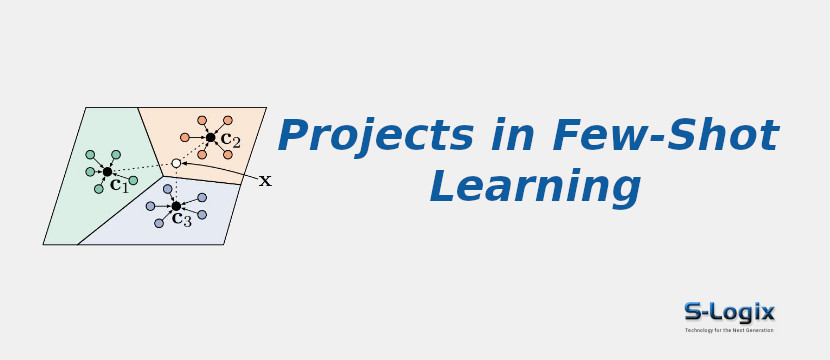Project Background:
Few-shot learning addresses the challenges of training machine learning models when only a limited amount of labeled data is available. Unlike conventional supervised learning paradigms that require extensive labeled datasets for each class, few-shot learning aims to enable models to generalize and make accurate predictions with minimal examples. It becomes particularly crucial when acquiring large labeled datasets is impractical or costly. Few-shot learning encompasses techniques, such as meta-learning and transfer learning, that empower models to leverage information from a few examples to adapt and perform well on new, unseen tasks. The motivation behind this project lies in the need for more flexible and adaptable machine learning systems that can quickly learn from limited data, resembling how humans acquire knowledge. By advancing few-shot learning techniques, the project aims to unlock the potential for machine learning models to excel in situations with sparse data, contributing to increased flexibility and efficiency in real-world applications.
Problem Statement
- Few-shot learning arises from the inherent limitations of traditional machine learning models that require large labeled datasets for effective training.
-
In many real-world scenarios, obtaining extensive labeled data for each target class is impractical or cost-prohibitive.
-
This limitation hinders the deployment of machine learning systems in situations where quick adaptation to new tasks or classes is crucial.
Few-shot learning aims to overcome this challenge by enabling models to generalize and make accurate predictions with only a few examples per class.
-
The central issues involve developing robust algorithms that can effectively leverage limited data, mitigate the risk of overfitting, and transfer knowledge across tasks.
-
Addressing these challenges is essential for successfully applying machine learning in diverse fields, from image recognition to natural language processing and medical diagnostics, where labeled data is often scarce.
Aim and Objectives
- Develop robust Few-Shot Learning techniques to enable machine learning models to generalize and perform effectively with limited labeled data.
-
Improve few-shot learning algorithms to enhance the models ability to adapt and generalize from a few examples.
-
Develop effective transfer learning strategies to leverage knowledge gained from one task to enhance performance on a related task with limited data.
-
Enhance the flexibility of machine learning models, allowing them to quickly adapt to new tasks or classes with minimal labeled data.
-
Investigate techniques for domain adaptation in few-shot learning, enabling models to perform well across diverse application domains.
-
Develop and employ appropriate evaluation metrics to accurately assess the performance of few-shot learning models in real-world scenarios.
Contributions to Few-Shot Learning
- It is developing and refining transfer learning strategies that enable models to leverage knowledge gained from one task to enhance performance on related tasks with sparsely labeled data.
-
Investigating and proposing domain adaptation techniques tailored for few-shot learning allow models to perform effectively across diverse application domains.
-
Introducing and refining evaluation metrics designed for few-shot learning scenarios accurately assesses model performance in real-world applications.
-
Applying few-shot learning techniques to specific domains, such as image recognition, natural language processing, and medical diagnostics, showcasing their practical efficacy in solving real-world challenges with limited labeled data.
-
Sharing implementations and findings as open-source resources contributes to the wider research community and fosters collaboration in the few-shot learning field.
-
Contributing to the enhancement of model flexibility enables machine learning models to quickly adapt to new tasks or classes with only a small number of labeled examples.
Deep Learning Algorithms for Few-Shot Learning
- Siamese Networks
-
Triplet Networks
-
Prototypical Networks
-
Memory-Augmented Networks (MANNs)
-
Model-Agnostic Meta-Learning (MAML)
-
Recurrent Neural Networks (RNNs) for Meta-Learning
-
Neural Architecture Search (NAS) for Few-Shot Learning
-
Attention Mechanisms (e.g., Self-Attention)
-
MetaGAN (Meta Generative Adversarial Networks)
Datasets for Few-Shot Learning
- Omniglot
-
NWay1Shot Omniglot
-
NWay5Shot Omniglot
-
Mini-ImageNet
-
Stanford Dogs Dataset
-
PlantCLEF
-
Tiered-ImageNet
-
MSCOCO
-
EuroSAT
-
ADE20K (ADE20K Scene Parsing)
-
LFW (Labeled Faces in the Wild)
-
ISIC Skin Cancer Classification
Performance Metrics
- Accuracy
-
Precision
-
Recall
-
F1 Score
-
Area Under the Receiver Operating Characteristic curve (AUC-ROC)
-
Area Under the Precision-Recall curve (AUC-PR)
Software Tools and Technologies
Operating System: Ubuntu 18.04 LTS 64bit / Windows 10
Development Tools: Anaconda3, Spyder 5.0, Jupyter Notebook
Language Version: Python 3.9
Python Libraries:
1. Python ML Libraries:
- Scikit-Learn
- Numpy
- Pandas
- Matplotlib
- Seaborn
- Docker
- MLflow
2. Deep Learning Frameworks:
- Keras
- TensorFlow
- PyTorch
Normalized Discounted Cumulative Gain (NDCG)-
Receiver Operating Characteristic Curve Analysis
-
Balanced Accuracy
-
Cross-Entropy Loss
